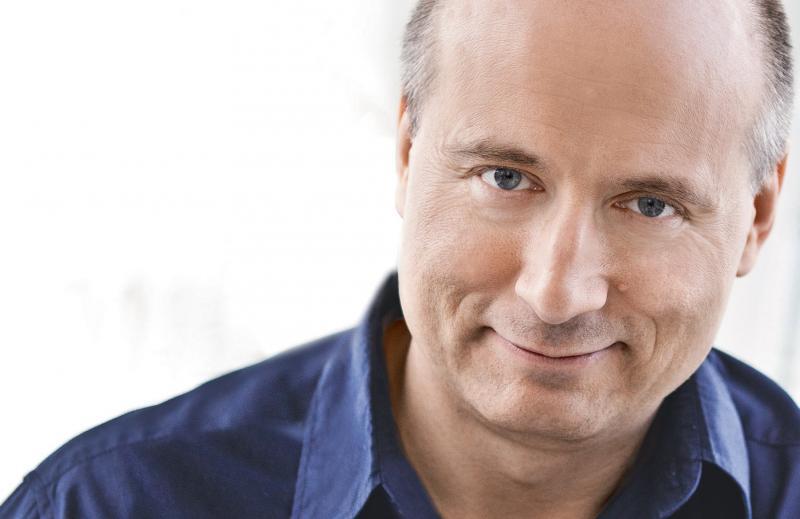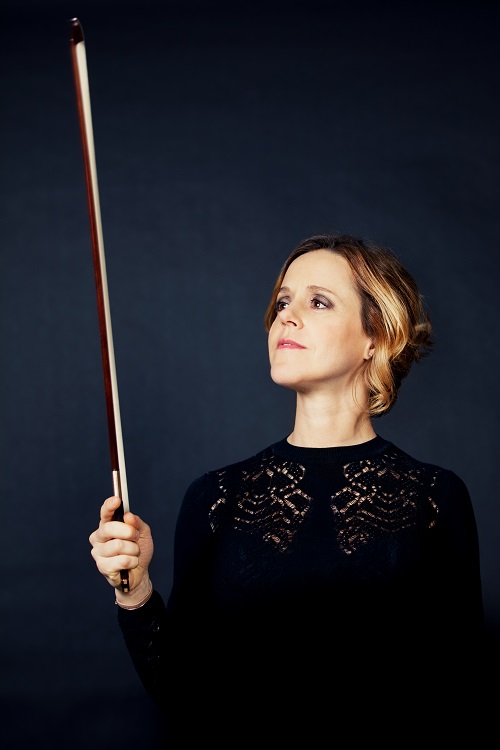Gabetta, NHK SO, Järvi, RFH review - transparency and dynamism | reviews, news & interviews
Gabetta, NHK SO, Järvi, RFH review - transparency and dynamism
Gabetta, NHK SO, Järvi, RFH review - transparency and dynamism
Japan’s flagship ensemble brings clarity and focus under its powerful chief conductor

This concert represented the British leg of the NHK Symphony Orchestra’s European tour. Tokyo’s radio orchestra is Japan’s flagship ensemble, and they are fine advocates for the country’s thriving musical culture, the playing precise and the tone focused.
The programme opened with Takemitsu’s How slow the wind, a late work from 1991. It is scored for chamber orchestra, with a repeating motif continually passed around the players in different moods and guises. The style always feels just a step removed from Debussy, the harmonies ambiguous without being dissonant, the rhythms in constant flux, yet serene. But Järvi took a more ritualistic angle, keeping the phrases regimented and distinct. The NHK string sound has a clear and light quality that was particularly valuable for the Takemitsu, giving the textures an elegant transparency, well matched to the woodwind and percussion solos above.
 Sol Gabetta (pictured left by Julia Wesely) was soloist for the Schumann Cello Concerto. Her restrained passion proved a good match for the NHK sound. Gabetta has a burnished, expressive tone, especially on the lower strings. In Schumann’s lyrical melodies, she often digs deep into the strings at the start of a phrase, but then trails off into dreamy but indistinct cadences. The orchestra accompanied with similar restraint, the dynamics minimal, the expression hesitant and muted. But it proved enough, with Gabetta providing enough charisma to carry the whole performance. For an encore, the quirky Dolcissimo by Pēteris Vasks: Gabetta’s encore for the First Night of the 2016 Proms, it just about retained its novelty value on a second hearing.
Sol Gabetta (pictured left by Julia Wesely) was soloist for the Schumann Cello Concerto. Her restrained passion proved a good match for the NHK sound. Gabetta has a burnished, expressive tone, especially on the lower strings. In Schumann’s lyrical melodies, she often digs deep into the strings at the start of a phrase, but then trails off into dreamy but indistinct cadences. The orchestra accompanied with similar restraint, the dynamics minimal, the expression hesitant and muted. But it proved enough, with Gabetta providing enough charisma to carry the whole performance. For an encore, the quirky Dolcissimo by Pēteris Vasks: Gabetta’s encore for the First Night of the 2016 Proms, it just about retained its novelty value on a second hearing.
Qualities of transparency and restraint hardly seem fitting for Rachmaninov, and so his Second Symphony, which ended the programme, required something more. This was Järvi’s second performance of the work at the Southbank Centre in little over a year (he conducted the Philharmonia in it last February). His tempos were generally brisk, and he often built climaxes up with intense agogic force, but the textures always remained clear, and the balances carefully judged. Järvi has a good feeling for the shape of large-scale Romantic symphonies (for the rest of the tour, they are concluding concerts with Bruckner’s Seventh) but it is not always obvious from the start. Here, the openings of both the first movement and the third-movement Adagio felt flat and underinflected. But in both movements, Järvi gradually warmed the music, finding ever-more colour and richness from the ensemble. In the Adagio he was helped by a seductively rich clarinet solo from Kenji Matsumoto.
The huge climax of this movement felt out of proportion, driven and furious – a towering peak in the music, as if Järvi and his players still had their minds on the Bruckner. The scherzo second movement fared better, the orchestra’s clean attacks and transparent textures carrying the music, even at the loudest dynamics. Järvi again pushed the tempos in the finale, but the orchestra also afforded it some grandeur, with the lower brass providing weight and the scurrying woodwinds propulsion. The fast tempos sometimes compromised the music’s solemnity, but Järvi instead offered dynamism and drama, his theatrical flair ensuring a real sense of exhilaration for the closing pages.
rating
Share this article
The future of Arts Journalism
You can stop theartsdesk.com closing!
We urgently need financing to survive. Our fundraising drive has thus far raised £49,000 but we need to reach £100,000 or we will be forced to close. Please contribute here: https://gofund.me/c3f6033d
And if you can forward this information to anyone who might assist, we’d be grateful.

Subscribe to theartsdesk.com
Thank you for continuing to read our work on theartsdesk.com. For unlimited access to every article in its entirety, including our archive of more than 15,000 pieces, we're asking for £5 per month or £40 per year. We feel it's a very good deal, and hope you do too.
To take a subscription now simply click here.
And if you're looking for that extra gift for a friend or family member, why not treat them to a theartsdesk.com gift subscription?
more Classical music
 Lammermuir Festival 2025 review - music with soul from the heart of East Lothian
Baroque splendour, and chamber-ensemble drama, amid history-haunted lands
Lammermuir Festival 2025 review - music with soul from the heart of East Lothian
Baroque splendour, and chamber-ensemble drama, amid history-haunted lands
 BBC Proms: Steinbacher, RPO, Petrenko / Sternath, BBCSO, Oramo review - double-bill mixed bag
Young pianist shines in Grieg but Bliss’s portentous cantata disappoints
BBC Proms: Steinbacher, RPO, Petrenko / Sternath, BBCSO, Oramo review - double-bill mixed bag
Young pianist shines in Grieg but Bliss’s portentous cantata disappoints
 theartsdesk at the Lahti Sibelius Festival - early epics by the Finnish master in context
Finnish heroes meet their Austro-German counterparts in breathtaking interpretations
theartsdesk at the Lahti Sibelius Festival - early epics by the Finnish master in context
Finnish heroes meet their Austro-German counterparts in breathtaking interpretations
 Classical CDs: Sleigh rides, pancakes and cigars
Two big boxes, plus new music for brass and a pair of clarinet concertos
Classical CDs: Sleigh rides, pancakes and cigars
Two big boxes, plus new music for brass and a pair of clarinet concertos
 Waley-Cohen, Manchester Camerata, Pether, Whitworth Art Gallery, Manchester review - premiere of no ordinary violin concerto
Images of maternal care inspired by Hepworth and played in a gallery setting
Waley-Cohen, Manchester Camerata, Pether, Whitworth Art Gallery, Manchester review - premiere of no ordinary violin concerto
Images of maternal care inspired by Hepworth and played in a gallery setting
 BBC Proms: Barruk, Norwegian Chamber Orchestra, Kuusisto review - vague incantations, precise laments
First-half mix of Sámi songs and string things falters, but Shostakovich scours the soul
BBC Proms: Barruk, Norwegian Chamber Orchestra, Kuusisto review - vague incantations, precise laments
First-half mix of Sámi songs and string things falters, but Shostakovich scours the soul
 BBC Proms: Alexander’s Feast, Irish Baroque Orchestra, Whelan review - rapturous Handel fills the space
Pure joy, with a touch of introspection, from a great ensemble and three superb soloists
BBC Proms: Alexander’s Feast, Irish Baroque Orchestra, Whelan review - rapturous Handel fills the space
Pure joy, with a touch of introspection, from a great ensemble and three superb soloists
 BBC Proms: Moore, LSO, Bancroft review - the freshness of morning wind and brass
English concert band music...and an outlier
BBC Proms: Moore, LSO, Bancroft review - the freshness of morning wind and brass
English concert band music...and an outlier
 Willis-Sørensen, Ukrainian Freedom Orchestra, Wilson, Cadogan Hall review - romantic resilience
Passion, and polish, from Kyiv's musical warriors
Willis-Sørensen, Ukrainian Freedom Orchestra, Wilson, Cadogan Hall review - romantic resilience
Passion, and polish, from Kyiv's musical warriors
 BBC Proms: Faust, Gewandhausorchester Leipzig, Nelsons review - grace, then grandeur
A great fiddler lightens a dense orchestral palette
BBC Proms: Faust, Gewandhausorchester Leipzig, Nelsons review - grace, then grandeur
A great fiddler lightens a dense orchestral palette
 BBC Proms: Jansen, Royal Concertgebouw Orchestra, Mäkelä review - confirming a phenomenon
Second Prom of a great orchestra and chief conductor in waiting never puts a foot wrong
BBC Proms: Jansen, Royal Concertgebouw Orchestra, Mäkelä review - confirming a phenomenon
Second Prom of a great orchestra and chief conductor in waiting never puts a foot wrong
 BBC Proms: Royal Concertgebouw Orchestra, Mäkelä review - defiantly introverted Mahler 5 gives food for thought
Chief Conductor in Waiting has supple, nuanced chemistry with a great orchestra
BBC Proms: Royal Concertgebouw Orchestra, Mäkelä review - defiantly introverted Mahler 5 gives food for thought
Chief Conductor in Waiting has supple, nuanced chemistry with a great orchestra

Add comment